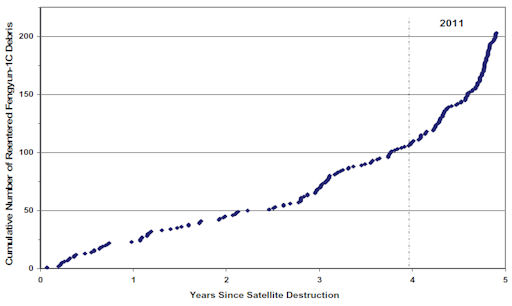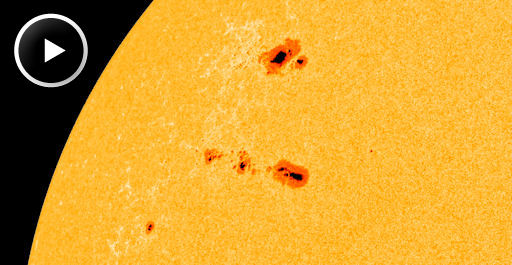CHANCE OF AURORAS: NOAA forecasters estimate a 15% to 20% chance of polar geomagnetic storms during the next 24 hours in response to a possible glancing blow from a CME. High-latitude sky watchers should be alert for auroras. Aurora alerts: text, voice.
INCREASING SOLAR ACTIVITY CLEANS UP SAT-DEBRIS: Earth's atmosphere has been puffing up in response to increasing levels of UV radiation from sunspots. This is good news for satellite operators, because a puffed up atmosphere helps clean up low-Earth orbit. "The number of cataloged debris in Earth orbit actually decreased during 2011," reports Nick Johnson in NASA's Orbital Debris Quarterly newsletter. "[The figure below] illustrates how the rate of debris reentries from the Fengyun-1C anti-satellite test of January 2007 increased during the past year."
"Even though only 6% of the total 3218 cataloged debris from the ill-advised engagement had reentered by the end of 2011, half of these debris fell out of orbit in the past 12 months," he points out. "Likewise, many debris from the 2009 accidental collision of Cosmos 2251 and Iridium 33 are accelerating their departure from Earth orbit. In the absence of a new major satellite breakup, the overall orbital debris population should continue to decrease during 2012 and 2013."
ADVANCING SUNSPOTS: A phalanx of sunspots is turning toward Earth. Their advance is documented in this two-day movie from the Solar Dynamics Observatory:
The large one in the middle, AR1401, has a "beta-gamma" magnetic field that harbors energy for M-class solar flares. At the moment it is unleashing one such flare every day, such as this flash recorded during the late hours of Jan. 19th. Eruptions from AR1401 will become increasingly geoeffective in the days ahead as the sun's rotation aligns the active region with our planet.
![]()

![]()
Solar wind
speed: 361.9 km/sec
density: 5.6 protons/cm3
explanation | more data
Updated: Today at 1336 UT
![]()
X-ray Solar Flares
6-hr max: C3 1250 UT Jan19
24-hr: C3 1250 UT Jan19
explanation | more data
Updated: Today at: 1300 UT
![]()
![]()
![]()
Daily Sun: 19 Jan 12
![]()
![]()
Sunspot 1401 poses a threat for M-class solar flares. Credit: SDO/HMI
![]()
![]()
![]()
Sunspot number: 122
What is the sunspot number?
Updated 18 Jan 2012
Spotless Days
Current Stretch: 0 days
2012 total: 0 days (0%)
2011 total: 2 days (<1%)
2010 total: 51 days (14%)
2009 total: 260 days (71%)
Since 2004: 821 days
Typical Solar Min: 486 days
Updated 18 Jan 2012
The Radio Sun
10.7 cm flux: 148 sfu
explanation | more data
Updated 18 Jan 2012
![]()
![]()
![]()
Current Auroral Oval:
Switch to: Europe, USA, New Zealand, Antarctica
Credit: NOAA/POES
![]()
![]()
![]()
Planetary K-index
Now: Kp= 1 quiet
24-hr max: Kp= 1 quiet
explanation | more data
![]()
Interplanetary Mag. Field
Btotal: 4.7 nT
Bz: 0.6 nT south
explanation | more data
Updated: Today at 1337 UT
![]()
![]()
![]()
Coronal Holes: 19 Jan 12
![]()
![]()
There are no large coronal holes on the Earthside of the sun. Credit: SDO/AIA.






